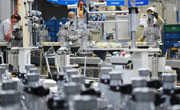Île-de-France(France)
Île-de-France(France)
[Overview] Situated in northern France, Île-de-France is one of the 13 regions in France, with a population of 12.14 million in an area of 12,012 square kilometers.
[Politics] Île-de-France is made up of Paris, the country's capital city, as well as seven departments including Val-de-Marne, Seine-Saint-Denis, Hauts-de-Seine, Yvelines, Val-d'Oise, Seine-et-Marne, and Essonne and has jurisdiction over 1,276 communes. Paris is both a city and a department. Due to its special status, Paris is not subordinate to but independent of Île-de-France.
Île-de-France is governed by the Regional Council, the government elected by the Regional Council, and the advisory councils. Members of the Regional Council are directly elected by universal suffrage and the number of members is determined by the population of the region. Except when changes are made to the Electoral Law, the term of office of Regional Council members is generally six years. The President of the Regional Council, elected by its members by absolute majority, is responsible for preparing and executing the decisions of the regional assembly, managing the assets, referring matters to the Economic, Social and Environmental Council, managing the regional administration, and chairing the standing committee. The regional government is represented by the President of the Regional Council and has an executive consisting of the President and 15 Vice-Presidents. Functional departments of the regional government are responsible for implementing the regional policies. The regional advisory councils, including the Economic, Social and Environmental Council, the Youth Advisory Council and the Advisory Council for Persons with Disabilities, are responsible for consulting the citizens of the region on relevant issues and notifying them of relevant resolutions of the region. The incumbent President of the Regional Council, Valérie Pécresse, took office in December 2015.
[Economy] Île-de-France is the economic center of France. In Europe, its economic status is second only to London, and it ranks first among all regions in Europe by the number of Fortune 500 companies. Île-de-France has a highly diversified economy and the region's pillar industries include aviation, aerospace and defense, automotive, business services, smart cities, financial services, insurance, and information technology. Île-de-France has the most developed agricultural product processing industry in France. More than 50% of the land in the region is used for agricultural purposes. It is a large producer of grains, beans and sugar beets. Île-de-France has well-developed infrastructure, including expressways, high-speed railways and air transportation, as well as a sound public transportation system.
[Culture and Education] Île-de-France has diverse cultural heritage and there are about 4,000 historical sites in the region, including four UNESCO World Heritage sites – the Palace and Park of Versailles, the Palace and Park of Fontainebleau, the Banks of the Seine River, and Provins, Town of Medieval Fairs. The region regularly holds various cultural activities. There are many museums, cinemas, opera houses, and cultural institutions in the region. Île-de-France has rich educational resources. It is home to many of the world's top research universities, business schools, and engineering and vocational colleges. Île-de-France is also a popular tourist destination. It receives 50 million tourists from across the world every year, making it one of the most visited tourist destinations in the world.
[Relations with Beijing] On July 2, 1987, Beijing and Île-de-France established a sister city relationship. On June 12, 2018, they signed the Beijing and Île-de-France Joint Action Plan 2018-2023. In recent years, Beijing and Île-de-France have engaged in frequent official exchanges and productive cooperation in the fields of science, technology, culture, education, environmental protection, and urban planning and management.
Scientific and Technological Innovations: In June 2018, the Zhongguancun-Île-de-France Industrial Innovation Center was unveiled in Beijing. In October 2018, with the support of Beijing, Île-de-France and the French Embassy in China, Beihang University and the Ecoles Centrales Group set up the Future City Laboratory in Beijing. In January 2019, the Administrative Committee of Zhongguancun Science Park established a liaison office at Station F, a business incubator for startups in Paris.
Culture and Education: From 2014 to 2015, Beijing and Île-de-France were working together on a vocational training project – Beijing Dispatch Plan, according to which Île-de-France sent 10 young people to Beijing in several groups for a six-month internship. In June 2016, at the third meeting of the China-France High-level Mechanism for Dialogue on People-to-People Exchanges, Beijing and France signed the Framework Agreement on the Construction of Fondation de Chine in Paris' International University City. Construction started for the Fondation de Chine Project in March 2019.
Other Fields: Five districts of Beijing have established collaborative or sister city relationships with six cities or other parts of Île-de-France. The education, environmental, social security, water affairs, urban planning, investment promotion and other authorities of Beijing and Île-de-France have signed many memoranda or agreements on cooperation.
巴黎大区(法国)
【概况】巴黎大区是法国13个大区之一,位于法国北部,面积12012平方公里,人口1214万。
【政治】巴黎大区由首都巴黎市和瓦尔德马恩、塞纳-圣但尼、上塞纳、伊夫林、瓦尔德瓦兹、塞纳-马恩和埃松七省组成,辖1276个市镇。巴黎市作为法国首都同时具有市和省的权限,其地位特殊,与巴黎大区彼此独立,无上下级关系。
巴黎大区政体包括大区议会、由大区议会产生的政府以及顾问委员会。大区议员由直选产生,人数由大区人口数量决定。根据选举法规定,除发生对选举法变更的情况,议员任期一般为6年。大区议会主席由议员选举产生,需获得议会绝对多数选票,其职责包括起草议会决议草案、落实执行议会决议、管理议会财产、管理大区经济社会理事会、领导大区执行机构、主持常设委员会等。大区政府由大区议会主席代表,下设由议会主席和15位副主席组成的执行局。大区各职能部门为大区执行机构,负责实施大区政策。大区顾问委员会负责就相关问题征询大区民众意见并通告大区相关决议,包括经济、社会和环境委员会,青年委员会和残疾公民顾问委员会等。现任议会主席瓦莱丽·佩克雷斯于2015年12月就职。
【经济】巴黎大区是法国经济中心。在欧洲,其经济地位仅次于伦敦,是排名欧洲第一的《财富》世界500强企业聚集地。巴黎大区是一个高度多元化的经济体,关键产业包括航空、航天与国防、汽车、商业服务、智慧城市、金融服务、保险、信息技术等。巴黎大区是法国农产品加工业最为发达的地区,50%以上的土地为农业用地,盛产谷物、豆类和甜菜。巴黎大区拥有良好的基础设施,高速公路、高速铁路和航空运输发达,公共交通系统完善。
【文化教育】巴黎大区拥有多元的文化遗产,历史古迹约4000个,包括凡尔赛宫、枫丹白露城堡花园、巴黎塞纳河两岸、普罗万中世纪城市四项世界文化遗产。大区定期举办各类文化活动,区内博物馆、电影院、歌剧院、文化机构众多。巴黎大区教育资源丰富,拥有许多世界一流的研究型大学、商学院以及工程与专业院校。巴黎大区还是著名的旅游胜地,每年接待国内外游客5000万,是世界上接待游客最多的地区之一。
【两市交往】1987年7月2日,北京市与巴黎大区正式建立友好城市关系。2018年6月12日,两市区签署《中华人民共和国北京市与法兰西共和国巴黎大区共同行动计划2018-2023》。近年来,两市保持着良好的官方往来,双方在科技、文教、环保、城市规划管理等领域开展了富有成效的合作。
科技创新:2018年6月,中关村—巴黎大区产业创新中心在京揭牌成立。2018年10月,在我市、巴黎大区及法国驻华使馆的联合支持下,北京航空航天大学和法国中央理工大学集团在京设立中法“未来城市实验室”。2019年1月,中关村管委会在巴黎初创公司园区Station F设立法国巴黎联络处。
文化教育:2014年至2015年,我市与巴黎大区实施了职业培训合作项目—“北京派遣计划”。巴黎大区共选派10名青年分批来京进行了为期6个月的实习。2016年6月,中法高级别人文交流机制第三次会议期间,我市与法方签署《建造巴黎国际大学城“中国之家”框架协议》,“中国之家”项目于2019年3月启动施工。
其他交往:此外,我市5个区与巴黎大区6个城市或地区也分别建立了友好合作或友城关系。两市区教育、环保、社保、水务、城市规划、投促等部门签署了相关领域的合作备忘录或协议。
(Source: Foreign Affairs Office of Beijing Municipal Government)
[ Editor: WPY ]










More From Guangming Online
Medics from Fujian leave for Shanghai to aid in battle against COVID-19 resurgence
New int'l land-sea transport service to Indo-China Peninsula launched
Another makeshift hospital under construction in Shanghai
Tourists view tulips in Suiping County, Henan
In pics: blooming gagea flowers on grassland in Zhaosu, Xinjiang
Greek workers stage 24-hour general strike over high prices